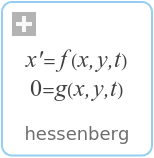WOLFRAM SYSTEM MODELER
hessenbergReturn upper Hessenberg form of a matrix |
|
Wolfram Language

SystemModel["Modelica.Math.Matrices.hessenberg"]

Information
This information is part of the Modelica Standard Library maintained by the Modelica Association.
Syntax
H = Matrices.hessenberg(A);
(H, U) = Matrices.hessenberg(A);
Description
Function hessenberg computes the Hessenberg matrix H of matrix A as well as the orthogonal transformation matrix U that holds H = U'*A*U. The Hessenberg form of a matrix is computed by repeated Householder similarity transformation. The elementary reflectors and the corresponding scalar factors are provided by function "Utilities.toUpperHessenberg()". The transformation matrix U is then computed by LAPACK.dorghr.
Example
A = [1, 2, 3;
6, 5, 4;
1, 0, 0];
(H, U) = hessenberg(A);
results in:
H = [1.0, -2.466, 2.630;
-6.083, 5.514, -3.081;
0.0, 0.919, -0.514]
U = [1.0, 0.0, 0.0;
0.0, -0.9864, -0.1644;
0.0, -0.1644, 0.9864]
and therefore,
U*H*transpose(U) = [1.0, 2.0, 3.0;
6.0, 5.0, 4.0;
1.0, 0.0, 0.0]
See also
Syntax
Inputs (1)
| A |
Type: Real[:,size(A, 1)] Description: Square matrix A |
|---|
Outputs (2)
| H |
Type: Real[size(A, 1),size(A, 2)] Description: Hessenberg form of A |
|---|---|
| U |
Type: Real[size(A, 1),size(A, 2)] Description: Transformation matrix |
Revisions
- 2010/05/31 by Marcus Baur, DLR-RM
